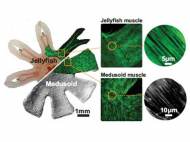Medusoid – artificial jellyfish swims in a heartbeat
 A team of researchers at Harvard University and the California Institute of Technology (Caltech) managed to combine inanimate silicon and living cardiac muscle cells into a freely swimming “jellyfish”. Aside proving reverse engineering of variety of muscular organs and simple life forms, it suggests a broader definition of what counts as synthetic life and it raises a debate about ethics.
A team of researchers at Harvard University and the California Institute of Technology (Caltech) managed to combine inanimate silicon and living cardiac muscle cells into a freely swimming “jellyfish”. Aside proving reverse engineering of variety of muscular organs and simple life forms, it suggests a broader definition of what counts as synthetic life and it raises a debate about ethics.
The tissue-engineered “jellyfish”, dubbed Medusoid, propels itself through the water by pumping in a similar way heart moves blood throughout the body. The researchers relied on recent advances in marine biomechanics, materials science, and tissue engineering, to figure out how to take apart and then rebuild the primary motor function of a jellyfish, worked to gain new insights into how such pumps work.
“It occurred to me in 2007 that we might have failed to understand the fundamental laws of muscular pumps”, said Kevin Kit Parker, Tarr Family Professor of Bioengineering and Applied Physics at the Harvard School of Engineering and Applied Sciences (SEAS). “I started looking at marine organisms that pump to survive. Then I saw a jellyfish at the New England Aquarium, and I immediately noted both similarities and differences between how the jellyfish and the human heart pump.”
To build the Medusoid, Parker collaborated with Janna Nawroth, a doctoral student in biology at Caltech and lead author of the study, who performed the work as a visiting researcher in Parker’s lab. They also worked with Nawroth’s adviser, John Dabiri, a professor of aeronautics and bioengineering at Caltech, who is an authority on biological propulsion.
“A big goal of our study was to advance tissue engineering,” said Nawroth. “In many ways, it is still a very qualitative art, with people trying to copy a tissue or organ just based on what they think is important or what they see as the major components — without necessarily understanding if those components are relevant to the desired function, or without analyzing first how different materials could be used.”
To reverse engineer a “Medusa” jellyfish, the investigators used analytical tools borrowed from the fields of law enforcement biometrics and crystallography to make maps of the alignment of subcellular protein networks in all of the animal’s muscle cells. That enabled them to analyze electrophysiological triggering which occurs during jellyfish propulsion and the biomechanics of the propulsive stroke itself.
That data was used to electrically stimulate a sheet of cultured rat heart muscle tissue that would contract and mimic an artificial jellyfish. The team then incorporated a silicone polymer that fashions the body of the artificial creature into a thin membrane that resembles a small jellyfish, with eight arm-like appendages.
Using the same analytical tools, the investigators were able to quantitatively match the subcellular, cellular, and supracellular architecture of the jellyfish musculature with the rat heart muscle cells.
The artificial construct was placed in a container of oceanlike saltwater and shocked into swimming with synchronized muscle contractions that mimic those of real jellyfish.
“I was surprised that with relatively few components — a silicone base and cells that we arranged — we were able to reproduce some pretty complex swimming and feeding behaviors that you see in biological jellyfish”, said Dabiri.
Looking forward, the researchers aim to evolve the artificial jellyfish, allowing it to turn and move in a particular direction, and even incorporating a simple “brain” so it can respond to its environment and replicate more-advanced behaviors like heading toward a light source and seeking energy or food.
Parker said he took on the challenge of synthetic biology that is focused on genetic manipulations of cells and decided to build a creature instead. Although this raises questions in ethics, the research could be used for advances in reverse engineering of muscular organs in humans, thus improving future tissue engineering.









Leave your response!